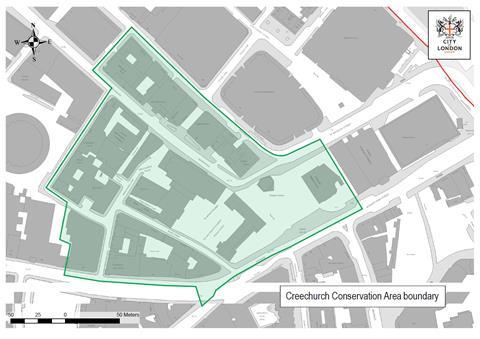The new heritage zone offers welcome protection against loss of daylight and privacy, writes Dan Press

The publication of Deloitte’s recent crane survey came just weeks after the City of London Corporation released a new visualisation featuring 11 new tall buildings that have been approved (or received a resolution of approval) in the last 12 months. With such momentum fuelling the growth of the City’s skyline, it is more important than ever that we protect its rich history and architectural character.
Conservation areas were originally established with the vision of protecting and preserving areas of historical, architectural, and cultural significance. Today, they continue to play a pivotal role in safeguarding the assets and landmarks that represent the richness of London’s unique identity and charm, in the face of modern urbanisation and unsympathetic development pressures.
Over December and January, after an extensive consultation, the Corporation decided to officially designate a new conservation area between Creechurch, Leadenhall and Aldgate in the east of the City. The new heritage zone includes the Bevis Marks synagogue and incorporates 31 Bury Street, the site of a controversial proposal for a 48-storey tower designed by Stiff + Tevellion, which was rejected in 2021. Objections to the tower were raised by Historic England, Historic Royal Palaces and representatives from Bevis Marks, the UK’s oldest synagogue.

Official guidance emphasises that structures within these areas need not have individual heritage significance, as such protection can be addressed through listing. Instead, conservation area designation recognises the overall quality and distinctiveness of the entire area, allowing a comprehensive approach that considers not only buildings and structures but also encompasses the tangible and intangible. These areas are designated based on these values and are accompanied by specific guidelines and regulations to preserve and enhance the neighbourhood character.
It could be argued that the original vision of conservation areas does not always align with evolving urban needs and changing demographics in contemporary city planning. Over recent decades the City of London has attracted massive investment, leading to the construction of iconic landmarks, and transforming the skyline into a symbol of the city’s prosperity and growth. Heritage buildings are however still susceptible to inconsiderate development, which risk detracting from the existing context; towering structures overshadowing and depriving low-lying buildings of natural light and privacy.
London’s preservation of key sightlines of St Paul’s is an example of one method to maintain historical perspectives. In New York City, contextual zoning laws are used to protect heritage and low-rise areas, while in Paris, the re-instated height limit ban prevents new buildings above 12 storeys (37m), a key move in the Local Bioclimatic Urban Plan aimed at reducing Paris’s carbon emissions.
We are currently at a critical juncture in addressing our climate crisis, searching for a fundamental shift to reduce both embodied and operational carbon in construction. Environmental concerns related to development, including the demolition of existing structures, add to the broader challenges of sustainable urban development. In this context, preserving existing buildings becomes a practical solution, and retrofitting offers a viable and advantageous alternative to new construction in our cities.

Creechurch Conservation Area plays a central role in the communal and economic life in the City of London. The harmonious low-rise scale of buildings fronting the narrow streets add to the character and appearance of the area’s special architectural, cultural, and historical interest. With the presence of the Roman city wall and several highly graded statutorily listed buildings of both Jewish and Christian significance, Creechurch boasts a remarkably rich heritage.
Notably, Bevis Marks Synagogue, established in 1701, stands as the UK’s oldest synagogue, built to the designs of Joseph Avis, a master builder who had worked under Christopher Wren. The existence of the only synagogue in Europe that has continuously held services for over 300 years is something to celebrate, not to cast in the shadow of another tall building in the name of growth. Real growth is in cherishing the diversity of coexistence.
The boundary lines adopted for the conservation area were developed collaboratively by Bevis Marks Synagogue and expert professionals. Their aim was to honour the historical setting, including the numerous historic churches, listed structures, and sites of historic Jewish worship, creating a comprehensive and relevant area with layers of religion and work.
The Creechurch Conservation Area helps protect buildings or places with architectural or historic interest in the area. Within the new draft City Plan, ‘The City Cluster’ discusses the ‘Character and Feel’ of London’s World City Status and proposed goal for ‘Protecting and enhancing the immediate setting of Bevis Marks Synagogue.’
Recent planning applications for tall buildings had posed a threat to the area’s existing character and appearance, with Bevis Marks Synagogue at the forefront of battles against the potential blockage of daylight by neighbouring tower blocks, thereby jeopardising the future of the site. By including within the boundary lines a site where developers had planned to construct a new 48-storey skyscraper, the City of London has taken a welcome step towards protecting its diverse heritage.
Postscript
Dan Press is a senior architect at Purcell
















1 Readers' comment